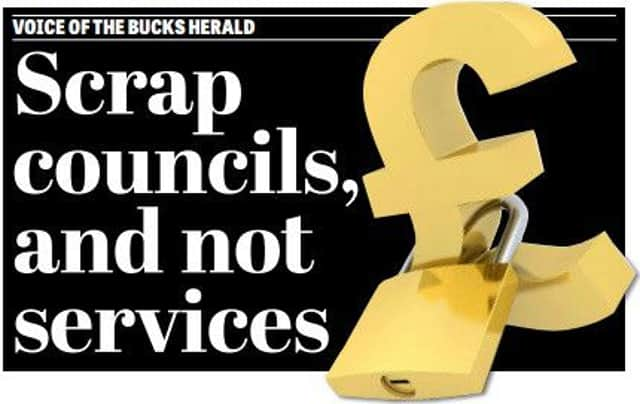UNITARY: All you need to know on the two arguments and why you should care


Councils are responsible for tangible things like bin collections, street cleaning, museums, libraries, social services and environmental health, not to mention the impact they have on our bank balance with the imposition of council tax.
And it’s money, stupid, which has brought us to this crisis point. Central government funding cuts and the wider malaise in the economy have left councils strapped for cash and needing to find more and creative savings to their budgets.
Advertisement
Hide AdAdvertisement
Hide AdNow, Bucks County Council is proposing the daddy of all changes in a bid to save money and protect what services are left.
A single, unitary authority would combine the forces of the four smaller district councils in our area into one supra-council which, in theory, would pool resources and save cash though economies of scale.
Of course, those very district councils aren’t such big fans of the idea as they all rather like their status and jobs, thank you very much.
So Aylesbury Vale District Council and the three other district councils in the county last week released a counter proposition for how local authorities might operate in the future.
Advertisement
Hide AdAdvertisement
Hide AdBucks County Council’s ‘Future Vision’ (more information is available via the website http://futurebucks.co.uk)
“One new council for Buckinghamshire - better, truly local services. One contact point for services and saving millions” screams a blue neon logo on the county council’s website.
It has summarised its argument into three headings: simpler, better value and closer.
Aylesbury Vale District Council, as well as the three other district councils in our county, Chiltern, South Bucks and Wycombe, commissioned an independent analysis of the options for reforming the council structure, which was released as the Herald went to press last Wednesday. They published a 94-page report by accountants Deloiite and a 10-page summary for its plan, which proposes abolishing the county council.
Advertisement
Hide AdAdvertisement
Hide AdBoth argue that their plans ‘modernise’ local government - here’s a summary of the arguments put forward by both camps.
Simpler?
The county council says there will be a one-stop-shop for residents and businesses to access all council services across the county. There would be one website and phone number for customers to use.
All services will be under one chief executive “leading to more joined-up thinking and better services” and it argues that many services are already delivered on a countywide basis.
The districts say: “The two or three-unitary option provides the greatest opportuinity to transform local government and achieve long-term financial and operational sustainability.”
Better value?
Advertisement
Hide AdAdvertisement
Hide AdBucks County Council says its plan will save taxpayers millions of pounds at a time of severe financial pressur
es. It will ‘massively’ increase efficiency, buying power and economies of scale, and provide an opportunity to sell buildings no longer in use, raising millions more to invest in residents’ priorities. In 2010, the county and district councils combined received £88m in government funding. It was £71.5m in 2013/14 and £27.6m for the current 2016/17 financial year.
Both camps agree that central government funding via the Revenue Support Grant will reduce to nil by 2019/20.
The county wants to reduce ‘back-office duplication’ and ‘cut the bureaucratic and costly layers of local government’ and claims its plan will save taxpayers more than £18m a year and total savings of more than £45m over the first five years.
Advertisement
Hide AdAdvertisement
Hide AdThe districts’ preferred options would provide net savings of £66.6m (two-tier) or £63.4m (three-tier) over five years, it claims, and says total service expenditure by the existing five councils in Buckinghamshire in 2015/16 was £861.1m. The districts’ own report says the county council’s option would provide net savings of £80.7m over five years.
Structure
The county council says there will be a clearer link between councillors, parishes and local community activists and it proposes a partnership offering parish and town councils more powrer to take on services. The number of councillors sitting on local authorities in the county would reduce from 238 to 98, saving £1.2m.
It will also create 19 ‘community boards’ made up of local councillors to take decisions on issues such as funding for community groups and roads maintenance.
The districts argue that the two or three-unitary option provides the greatest opportuinity to transform local government and achieve long-term financial and operational sustainability.
Advertisement
Hide AdAdvertisement
Hide AdUnder their plan, a two-unit model would be based on the existing boundaries of Aylesbury Vale and one covering the combined existing boundaries of Chiltern, South Bucks and Wycombe district councils. Adult social care, children’s services, economic development, transport and spatial planning would be delivered countywide while environment, local planning, community, culture and leisure services would be delivered separately by the two units.
A three-unit model would be based on the existing boundaries of Aylesbury Vale, Wycombe district, and a third combining the existing boundaries of Chiltern and South Bucks districts. This would be the same as the above but with environment, local planning, community, culture and leisure services delivered separately by the three units.
The district councils argue that political accountability will be lost under the county’s plan and say “locally accountable decision-making” is needed.